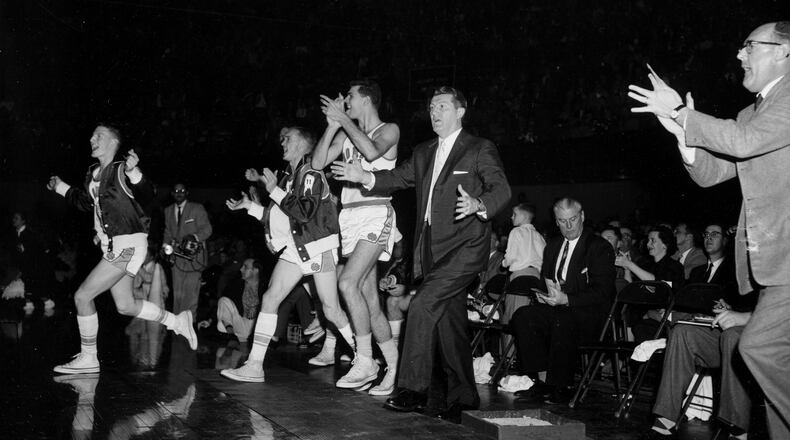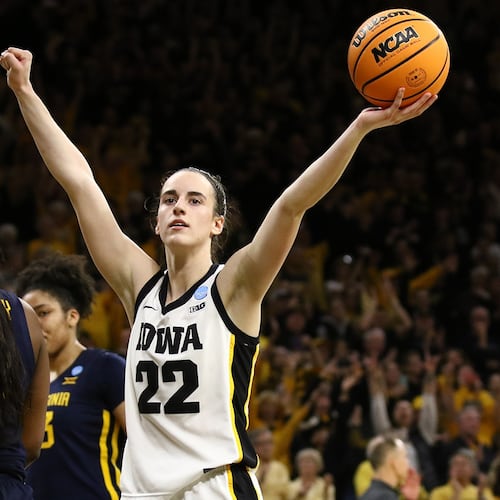Through the magic of YouTube, it's possible to watch the 1957 NCAA championship game almost in full. One caveat: The video is so grainy that numbers and faces are beyond recognition; even intermittent shots of the scoreboard are no help. Oh, and there's no audio.
Helpful hint No. 1: North Carolina is wearing white uniforms; Kansas is clad in dark. Hint No. 2: The player who stands almost a head taller than everyone else is a Jayhawk. His name: Wilt Chamberlain.
That the blurry video exists at all is a wonder. On the night of March 23, 1957, the title tilt was televised only in North Carolina. The NCAA tournament — folks then referred to it as “the nationals” — wasn’t yet a big deal. As late as the early ’50s, the New York-based NIT had been considered the more prestigious event. This careening weekend in Kansas City is considered the NCAA’s coming-out party.
North Carolina arrived ranked No. 1 and undefeated, though only just. The Tar Heels had trailed Maryland by four with 40 seconds left, whereupon coach Frank McGuire called timeout and instructed his players to be gracious losers. They stole the ball twice and won in double overtime. They would become the greatest multiple-overtime team ever.
Lennie Rosenbluth, a 6-foot-5 forward who could invent and make any shot, was the star. He hailed from the Bronx. The rest of Carolina's starting five was likewise from New York, though the other four were Catholic. So was McGuire, who'd come to Chapel Hill after leading St. John's to the 1952 NCAA finals, where it lost to Kansas. In an exhaustive recounting of Carolina's championship season — it ran 25 years after the fact — Sports Illustrated's Frank Deford wrote the McGuire instructed Rosenbluth to say a Hail Mary before a key free throw.
Said Rosenbluth, a Jew: “I don’t know how to say Hail Mary.”
Said teammate Pete Brennan: “We’ll say the Hail Mary. You make the shot.”
Rosenbluth was a senior. The four Catholics were juniors. (In a later manifestation as South Carolina’s coach, McGuire would again tap his New York pipeline.) All had the requisite Big Apple swagger, which would avail them mightily over a fraught season.
The Heels trailed by one against Wake Forest in the final seconds of the ACC tournament semifinals — a loss would have meant no NCAA bid — when Rosenbluth took the ball and turned into Wake's Wendell Carr. (An excellent UNC-produced documentary — "1957: The Year of McGuire's Miracle," also on YouTube — offers clear footage of the play.) Rosenbluth's hook shot dropped. He might have been called for a charge. Referee Jim Mills assessed a foul against Carr. Carolina won by two.
McGuire from the documentary: “I understand Bones (McKinney, the Wake coach) chased the referees all night and couldn’t find them.”
Four more victories lifted the 30-0 Heels into the national semifinals against Michigan State. The Spartans’ star was Johnny Green, known as Jumpin’ Johnny. With six seconds left in the first overtime, Green made a free throw for a two-point lead. He missed his second. Brennan rebounded and headed upcourt. His jumper over two defenders forced a second overtime. A third would be needed before the Heels won 74-70.
Up next was No. 2 Kansas and Chamberlain. There had been splendid collegiate big men before — Oklahoma A&M, which became Oklahoma State, won consecutive titles with 7-footer Bob Kurland; San Francisco had just won two in a row with Bill Russell – but there had never been one as big, fast, strong and skilled as Chamberlain. He averaged 29.6 points and 18.9 rebounds in what would be his only collegiate season. His Jayhawks routed reigning champ San Francisco (sans Russell, then a Boston Celtic) 80-56 in the other semi.
In a pregame meeting, McGuire asked Tommy Kearns, who was 5-11: “Are you afraid of Chamberlain? Then jump against him.” McGuire would later concede he hadn’t meant it, but sure enough, the opening tip paired Wilt, 7-1, and Kearns, 14 inches shorter. Even the blurry film can’t disguise Chamberlain’s reaction. He looks toward the Carolina bench, as if to say, “Are you kidding?” Then he controls the tip.
Kansas tried a box-and-one against Rosenbluth. The other New Yorkers shot the Heels to a 10-point lead. It was 29-22 at the half. Chamberlain got going thereafter. (He would later tell McGuire, his coach for one year with the NBA's Philadelphia Warriors, that he "felt like Custer" with so many defenders around him.) Rosenbluth fouled out with 1:45 left in regulation and Kansas up three. Kearns' free throws sent the game, inevitably, to overtime.
Carolina sub Bob Young, also from New York, scored on a drive in the first overtime. Chamberlain countered. Nobody scored again until the third OT, in which Kansas led 53-52 inside the final 10 seconds. Carolina center Joe Quigg took Brennan’s pass at the foul line and drove against Wilt, who blocked the shot. Maurice King, however, was called for a reach-in. Quigg made both free throws at 0:06.
Kansas coach Dick Harp called timeout. The Jayhawks tried to feed Chamberlain, duh, but Ron Loneski’s pass was too low. (In the view offered by the lone TV camera, Wilt isn’t in the frame.) Quigg deflected it to Kearns, who flung the ball on high to burn off the final seconds – or so he would claim. He might just have been excited.
The Heels flew home minus McGuire and Rosenbluth, diverted to New York to appear — like Elvis, like the Beatles — on “The Ed Sullivan Show.” They had to circle the Raleigh-Durham airport because, their pilot informed them, 10,000 people had swarmed the tarmac to greet them, and why not? Over two nights and six overtimes, they’d overcome Jumpin’ Johnny and Wilt the Stilt. The NCAA tournament would never be the same.
THE SERIES
No. 10: 1979
No. 9: 1991
No. 8: 1968
No. 7: 1982
No. 6: 1985
No. 5: 1974
No. 4: 1963
No. 3: 1966
No. 2: 1957
-♦-
About the Author
The Latest
Featured


